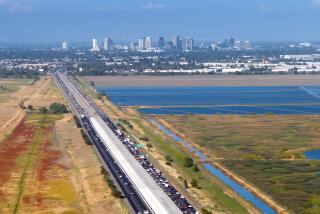Experts Find No Easy Answers to Lane Phenomenon
- Share via
Dear Street Smart:
Can you explain a phenomenon we have observed on freeways in California and throughout the country? Freeways are designed so that the leftmost lane is supposed to be the fastest moving lane. But in heavy traffic, the fastest lane is the right-most one. This holds true with few exceptions.
Locally, we make good use of our “right-lane rule” when traversing the El Toro Y at rush hour and in coming north from San Diego on weekends, when we pass the Border Patrol checkpoint near San Onofre. But it works almost everywhere. We move steadily, if not speedily, along in the right lane while our fellow motorists idle or advance at a slower rate.
We are puzzled as to why this phenomenon works. The right lane should have the most traffic disturbances--cars going into and out of lanes--and we think that should make it slower. Conversely, the left lane should have the fewest disturbances, and we ought to move fastest. However, our observations prove this reasoning wrong, and we wonder if you could tell us why. Do other people notice this?
Barbara and Michael Bertin, Irvine
Street Smart couldn’t turn up any studies on this phenomenon, but both Caltrans traffic analyst Joe El-Harake and Prof. Mike McNally of UCI’s Institute of Transportation Studies took a stab at explaining it.
The consensus seems to be that the right lane may indeed help you move more quickly in some instances, but over the long haul, it probably won’t carry you along any faster.
Generally, Caltrans finds the right-most lane moves slower than other lanes, and for the reason you suspected--because cars are constantly moving into and out of it, El-Harake said.
Traffic congestion changes the rules. For one thing, it allows for what could be dubbed the “spurt” factor. That’s when a group of cars exits a slow-moving freeway from the right lane. Cars behind them are able to “spurt” forward into the vacated space, while vehicles in the adjoining lanes have no similar opportunity, McNally explained.
Of course, the right lane may slow down once more cars get on the freeway. But closely spaced exits might allow traffic to keep spurting forward. And El-Harake noted that some drivers may jump into an adjoining lane once the right lane begins to slow. That action probably doesn’t win any favors with other motorists and may even slow the freeway down, he said.
A freeway may also gain an additional lane on its right-hand side, allowing congested traffic to slide over and begin to move faster. Also, drivers may simply be jamming up those left lanes because they believe that they’ll move faster than the right lanes.
Armed with this knowledge of lane behavior, what should you do? El-Harake suggests you do what works for you.
“If the person feels it’s providing him a better way to get from Point A to Point B, it’s up to that individual,” he said.
McNally is a number two lane purist, believing that the lane next to the left-most lane is the fastest. That’s because the right lane may slow down as traffic enters or because slow-moving trucks are in it, while the fast lane is home to the more daring drivers who disrupt traffic flow, he explained.
“People in fast lane tend to be more aggressive drivers and put the pedal down a lot faster if there is space,” McNally said.
After this quick acceleration, these drivers may have to hit their brakes, causing a brake light “shock wave” that flows back through the lane.
“It’s these shock waves moving back that really slow down traffic,” McNally said.
Drivers next to the fast lane seem to leave themselves more room, allowing them to slow without hitting their brakes, McNally said. He suggested that if all drivers left themselves more room and watched farther ahead like this, things might move more quickly.
McNally quickly added that you can’t leave too much room ahead, of course, lest someone jump in front of you. After all, it’s still a jungle out there.
Dear Street Smart:
I want to know why it is taking so long for a section of University Drive to be repaved between Campus Drive and California Avenue, on the westbound side. There are many potholes that are in need of repair, especially after the recent rains. What are they waiting for, an accident?
Jeffrey Andrews, Lake Forest
Nope, Irvine just had to get the contract awarded. Work should begin today on repairing and completely resurfacing University Drive, from Campus to MacArthur, according to Irvine project engineer Tom Mazzola. Work will continue through mid-July.
Dear Street Smart:
I live at Carbon Creek Shores, an Anaheim complex of 40 units housing only permanently disabled tenants. We have great difficulty riding public transportation due to the lack of pavement to cross the Riverside Freeway, to reach the Route 38 bus on La Palma Avenue. Also, the Route 59 bus on nearby Kraemer Boulevard runs only during peak hours.
Barbara Skaggs, Anaheim
There don’t appear to be easy solutions to your problem. Orange County Transportation Authority spokeswoman Mona Ziada said there are no plans to increase Route 59 service. The route has no ridership growth, and the authority’s sales tax revenues are down because of the recession.
Nor can a bus line be rerouted along your small street, Ziada said. Her suggestion was that you use the dial-a-ride service to reach the bus on La Palma. More information on the service and fares is available by calling (714) 636-RIDE.
As for sidewalks, they are coming, but not right away. The sidewalks are scheduled for construction during the 1993-94 fiscal year, according to Chris Dahl, an Anaheim traffic engineer. When done, the sidewalks will extend along Kraemer from the Santa Ana River to La Palma.
More to Read
Sign up for Essential California
The most important California stories and recommendations in your inbox every morning.
You may occasionally receive promotional content from the Los Angeles Times.










